- 06 JUILLET
- INDI-UNI : 
PRE-INSCRIPTION : 15 Juin – 15 Août
PRE-REGISTRATION: June 15th - August 15th
ITALIE - 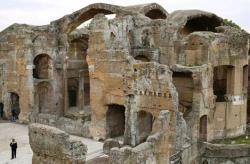 Tivoli - La Villa d'Hadrien, la résidence du célèbre empereur romain près de Rome, a dû fermer l'accès de nombreuses zones aux visiteurs en raison de risques d'écroulement dus au manque de moyens pour entretenir le site. La Villa a été construite entre 117 et 138 après Jésus-Christ sur ordre de l'empereur Hadrien, immortalisé entre autres dans les "Mémoires d'Hadrien" de Marguerite Yourcenar. Elle évoque par son architecture les ouvrages et les sites qu'Hadrien a visités lors de ses nombreux voyages dans l’Empire romain. Parmi les bâtiments les plus connus figurent notamment le Théâtre maritime et le Canope, un plan d'eau de 119 mètres de long sur 18 de large devant son nom à une ville égyptienne réputée pour ses cultes d'Isis et Sérapis, et également dédié à Antinoüs, favori d'Hadrien mort noyé.
Tivoli - La Villa d'Hadrien, la résidence du célèbre empereur romain près de Rome, a dû fermer l'accès de nombreuses zones aux visiteurs en raison de risques d'écroulement dus au manque de moyens pour entretenir le site. La Villa a été construite entre 117 et 138 après Jésus-Christ sur ordre de l'empereur Hadrien, immortalisé entre autres dans les "Mémoires d'Hadrien" de Marguerite Yourcenar. Elle évoque par son architecture les ouvrages et les sites qu'Hadrien a visités lors de ses nombreux voyages dans l’Empire romain. Parmi les bâtiments les plus connus figurent notamment le Théâtre maritime et le Canope, un plan d'eau de 119 mètres de long sur 18 de large devant son nom à une ville égyptienne réputée pour ses cultes d'Isis et Sérapis, et également dédié à Antinoüs, favori d'Hadrien mort noyé.
http://www.lefigaro.fr/flash-actu/2011/07/06/97001-20110706FILWWW00353-archeologie-la-villa-d-hadrien-menacee.php
- FRANCE 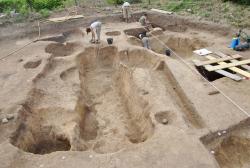 Châteaumeillant - Le programme de recherches archéologiques en cours sur l'oppidum de Châteaumeillant-Mediolanum (Cher) s'intégre dans une opération de fouille triennale, 2010-2011-2012. Ces recherches s'inscrivent à la suite du programme de fouilles précédent dans les quartiers d'habitat (2007-2009) et des fouilles sur les fortifications (2001-2006). Ce programme concerne l'exploration de l'habitat contemporain de l'exceptionnel rempart celtique de Châteaumeillant. Cet oppidum est le premier site biturige dont on explore l'intérieur. Les fouilles d'oppida étant très rares en Europe, on peut espérer que les résultats de ces recherches apporteront des données nouvelles à l'échelle de l'Europe celtique.
Châteaumeillant - Le programme de recherches archéologiques en cours sur l'oppidum de Châteaumeillant-Mediolanum (Cher) s'intégre dans une opération de fouille triennale, 2010-2011-2012. Ces recherches s'inscrivent à la suite du programme de fouilles précédent dans les quartiers d'habitat (2007-2009) et des fouilles sur les fortifications (2001-2006). Ce programme concerne l'exploration de l'habitat contemporain de l'exceptionnel rempart celtique de Châteaumeillant. Cet oppidum est le premier site biturige dont on explore l'intérieur. Les fouilles d'oppida étant très rares en Europe, on peut espérer que les résultats de ces recherches apporteront des données nouvelles à l'échelle de l'Europe celtique.
http://romanarcheo.blogspot.com/
- ESPAGNE – 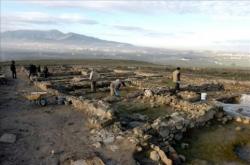 Puente Tablas - Excavations at Puente Tablas, the Iberian settlement which was discovered in Jaén at the beginning of the 1970s, have uncovered the remains of an Iberian palace which would have covered an area of 400 square metres 25 centuries ago. It’s the first to have ever been excavated in Andalucía. Archaeologists say construction started in the 5th Century BC and would have been completed over the next two centuries. It was built on two floors, with a central patio, a private area for the family, and a public area where the prince would have received his visitors. There was also a small sanctuary and a production area for oil and wine. Professor Ruiz, from the CAAI Andalucía Centre for Iberian Archaeology, described the discovery to El País as a quantum leap forward in our knowledge of life in Iberian times. The fortified city of Puente Tablas is some 7 kilometres outside Jaén’s provincial capital, to the north east of the city, and extended for more than five hectares. It would have had around 1,000 inhabitants in the 4th Century BC and is protected as a BIC Site of Cultural Interest.
Puente Tablas - Excavations at Puente Tablas, the Iberian settlement which was discovered in Jaén at the beginning of the 1970s, have uncovered the remains of an Iberian palace which would have covered an area of 400 square metres 25 centuries ago. It’s the first to have ever been excavated in Andalucía. Archaeologists say construction started in the 5th Century BC and would have been completed over the next two centuries. It was built on two floors, with a central patio, a private area for the family, and a public area where the prince would have received his visitors. There was also a small sanctuary and a production area for oil and wine. Professor Ruiz, from the CAAI Andalucía Centre for Iberian Archaeology, described the discovery to El País as a quantum leap forward in our knowledge of life in Iberian times. The fortified city of Puente Tablas is some 7 kilometres outside Jaén’s provincial capital, to the north east of the city, and extended for more than five hectares. It would have had around 1,000 inhabitants in the 4th Century BC and is protected as a BIC Site of Cultural Interest.
http://www.typicallyspanish.com/news/publish/article_31190.shtml#ixzz1RLYd1Itm
- ITALIE – 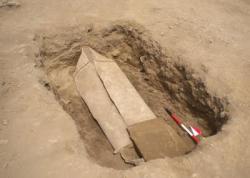 Gabii - Archaeologists have discovered an ancient Roman sarcophagus in the central Italian Lazio region surrounding Rome. It is the second sarcophagus discovered during a dig being coordinated by the University of Michigan. The sarcophagus was uncovered in the area of Lazio believed to the site of the ancient Roman city of Gabii, located 18 kilometres east of Rome. Both sarcophagi - coffins typically adorned with sculptures or inscriptions - are made of lead and are believed to date from the 1st or 2nd century AD. The first sarcophagus was unearthed in 2009 by archaelogists working on the same dig, the 'Gabii Project', which began in 2007. According the site director, archaelogist Anna Gallone, the two sarcophagi are examples of a unique funeral rite found in Gabii. The team of archaeologists gleaned information about Gabii during a 2007-2008 surface survey of the city, which was once a rival of ancient Rome.
Gabii - Archaeologists have discovered an ancient Roman sarcophagus in the central Italian Lazio region surrounding Rome. It is the second sarcophagus discovered during a dig being coordinated by the University of Michigan. The sarcophagus was uncovered in the area of Lazio believed to the site of the ancient Roman city of Gabii, located 18 kilometres east of Rome. Both sarcophagi - coffins typically adorned with sculptures or inscriptions - are made of lead and are believed to date from the 1st or 2nd century AD. The first sarcophagus was unearthed in 2009 by archaelogists working on the same dig, the 'Gabii Project', which began in 2007. According the site director, archaelogist Anna Gallone, the two sarcophagi are examples of a unique funeral rite found in Gabii. The team of archaeologists gleaned information about Gabii during a 2007-2008 surface survey of the city, which was once a rival of ancient Rome.
http://www.adnkronos.com/IGN/Aki/English/CultureAndMedia/Italy-Ancient-sarcophagus-unearthed-near-Rome_312206054175.html
- EGYPTE – 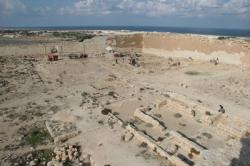 Taposiris Magna - A radar survey of the temple of Taposiris Magna, west of Alexandria, Egypt, was completed last month as part of the search for the tomb of Cleopatra and Mark Antony. The Supreme Council of Antiquities (SCA) expedition excavating the temple and its surrounding area is headed by Zahi Hawass, Secretary General of the SCA, and Dr. Kathleen Martinez, a scholar from the Dominican Republic.Dr. Hawass stated that the cooperation between Egypt and the Dominican Republic for the excavation of the temple has been ongoing for about three years. The recent radar survey is the most significant step taken by the team to date. The radar revealed 3 possible spots of interest where a tomb may be located. The expedition has received the results of the survey, and will begin excavating each of these three spots next week. The most important recent development at Taposiris Magna has been the discovery of a large, previously unknown cemetery outside the temple enclosure. The expedition has found 27 tombs. 20 of them shaped like vaulted sarcophagi, partly underground and partly aboveground. The remaining 7 consist of staircases leading to simple burial chambers. Inside these tombs, the team has found a total of 10 mummies, 2 of them gilded. The discovery of this cemetery indicates that an important person, likely of royal status, could be buried inside the temple. It was common for officials and other high-status individuals in Egypt to construct their tombs close to those of their rulers throughout the pharaonic period. The style of the newly discovered tombs indicates that they were constructed during the Greco-Roman period. Dr. Martinez stated that the expedition has excavated a temple at Taposiris Magna dedicated to the goddess Isis, and discovered coins depicting the face of Alexander the Great. They have found a number of deep shafts inside the temple, three of which seem to have been used for burials. It is possible that these shafts were the tombs of important people, and the team’s leaders believe that Cleopatra and Mark Antony could have been buried in a deep shaft similar to those already discovered inside the temple. Dr. Hawass said that the expedition has so far found a beautiful head of Cleopatra, along with 22 coins bearing her image. The statue and coins show her as a beauty, contradicting the idea recently suggested by an English museum curator that the queen was quite ugly. The finds from Taposiris reflect a charm that could have captured the hearts of Julius Caesar and Mark Antony, and indicate that Cleopatra was in no way unattractive. Moreover, the features of the sculpted head show no sign of African ancestry, contradicting a recently advanced theory. The team has also found many amulets, along with a beautiful headless statue dating to the Ptolemaic Period. Among the most interesting finds is a unique mask depicting a man with a cleft chin. The face bears some similarity to known portraits of Mark Antony himself.
Taposiris Magna - A radar survey of the temple of Taposiris Magna, west of Alexandria, Egypt, was completed last month as part of the search for the tomb of Cleopatra and Mark Antony. The Supreme Council of Antiquities (SCA) expedition excavating the temple and its surrounding area is headed by Zahi Hawass, Secretary General of the SCA, and Dr. Kathleen Martinez, a scholar from the Dominican Republic.Dr. Hawass stated that the cooperation between Egypt and the Dominican Republic for the excavation of the temple has been ongoing for about three years. The recent radar survey is the most significant step taken by the team to date. The radar revealed 3 possible spots of interest where a tomb may be located. The expedition has received the results of the survey, and will begin excavating each of these three spots next week. The most important recent development at Taposiris Magna has been the discovery of a large, previously unknown cemetery outside the temple enclosure. The expedition has found 27 tombs. 20 of them shaped like vaulted sarcophagi, partly underground and partly aboveground. The remaining 7 consist of staircases leading to simple burial chambers. Inside these tombs, the team has found a total of 10 mummies, 2 of them gilded. The discovery of this cemetery indicates that an important person, likely of royal status, could be buried inside the temple. It was common for officials and other high-status individuals in Egypt to construct their tombs close to those of their rulers throughout the pharaonic period. The style of the newly discovered tombs indicates that they were constructed during the Greco-Roman period. Dr. Martinez stated that the expedition has excavated a temple at Taposiris Magna dedicated to the goddess Isis, and discovered coins depicting the face of Alexander the Great. They have found a number of deep shafts inside the temple, three of which seem to have been used for burials. It is possible that these shafts were the tombs of important people, and the team’s leaders believe that Cleopatra and Mark Antony could have been buried in a deep shaft similar to those already discovered inside the temple. Dr. Hawass said that the expedition has so far found a beautiful head of Cleopatra, along with 22 coins bearing her image. The statue and coins show her as a beauty, contradicting the idea recently suggested by an English museum curator that the queen was quite ugly. The finds from Taposiris reflect a charm that could have captured the hearts of Julius Caesar and Mark Antony, and indicate that Cleopatra was in no way unattractive. Moreover, the features of the sculpted head show no sign of African ancestry, contradicting a recently advanced theory. The team has also found many amulets, along with a beautiful headless statue dating to the Ptolemaic Period. Among the most interesting finds is a unique mask depicting a man with a cleft chin. The face bears some similarity to known portraits of Mark Antony himself.
http://www.thewatchtowers.com/archaeologists-hawass-and-martinez-believe-they-may-have-found-the-tomb-of-antony-and-cleoptra/